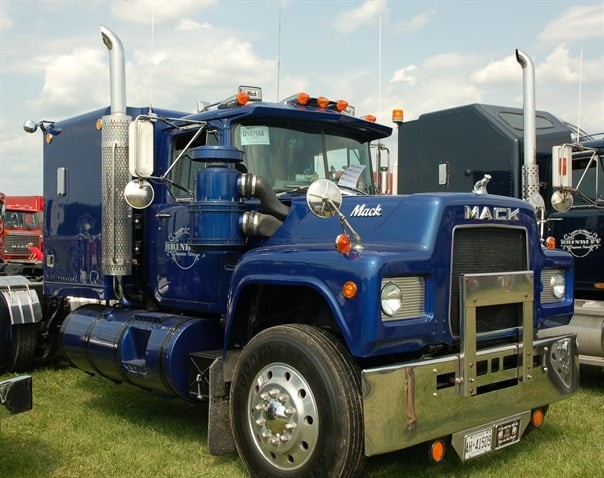For those in the trucking industry, the advancements in modern rigs are undeniable. Having spent time at the Classic and Antique Truck Show in Clifford, Ontario, it was a vivid reminder of just how far trucks have come. Sponsored by the Great Lakes Truck Club, the show featured over 200 pre-1975 vintage trucks alongside a strong showing of 1980s and 1990s long-nose and cab-over-engine (COE) classics. Walking through the rows of gleaming chrome and meticulously maintained machines, a wave of nostalgia hit as I recognized many models I had personally driven during my career. It felt like a reunion with old friends, each truck stirring up memories of a different time in trucking.
One particular model that always evokes fond memories is the Mack R-Model. My trucking journey began behind the wheel of a 1975 R-Model, and the appreciation for these trucks remains strong. While not known for spaciousness, with their smaller windows and challenging cab access, the R-Model was a driver’s truck. Its comfort and road-holding ability were exceptional, setting a high bar for trucks that followed. The Clifford show boasted a notable collection of well-preserved R-Models, each a testament to their enduring appeal.
Freightliner COEs were another prominent presence at the show, bringing back memories of my time at a previous company. While the fleet included these models, they were already showing their age even then. My assigned truck was a ’73 Freightliner COE, which, by 1980, was considered one of the older units in the fleet. Its short 164-inch wheelbase and manual steering, augmented with a peculiar air-assist system, presented unique driving characteristics. While the air-assist could be deactivated on the highway, it introduced a pulsing sensation in the steering, making tight cornering an exercise in managing jerky movements, unlike the sure-footedness of the R-Model.
These shorter wheelbase configurations were a direct response to length restrictions prevalent at the time, primarily for hauling A-train doubles. In my case, it was often tall, non-baffled tankers filled three-quarters full with asphalt, riding on air suspension. The combination of a short wheelbase truck, the unpredictable steering, and swaying tankers created a driving experience that was anything but monotonous.
In contrast to the shorter wheelbase units, my personal favorite in that fleet was a ’69 Freightliner with a substantial 220-inch wheelbase and a naturally aspirated 6V-71 Detroit Diesel engine. While it wasn’t a speed demon, especially when hauling 115,000-pound tri-axle loads, the ride quality was remarkably smooth. The Clifford show echoed these memories with several beautifully maintained Freightliner COEs on display.
The diverse range of 1980 Trucks I operated during my initial decade in the industry included some truly memorable machines. There was a late ’70s long-nose Western Star day cab, devoid of power steering, used for city deliveries. Another standout was an early ’80s Freightliner COE sleeper, boasting a 244-inch wheelbase and a “buzzin’ dozen” – a two-stroke V-12 Detroit Diesel under the doghouse. This engine, producing 525 horsepower at 2400 rpm but only 1,300 lb-ft of torque, was built for speed but lacked hill-climbing prowess. Then there was the rare Cummins 903 V-8, found in a Hayes COE with a Mack F700-style cab. Primarily used in farm equipment, boats, and locomotives, the 903 was a distinctive and incredibly loud engine, occasionally retrofitted into trucks.
Over my career, I estimate having driven around 25 different makes and models, encompassing Freightliner conventionals and COEs, GMC Brigadiers, Generals, and Astros, White Road Bosses, Road Commanders, and Mustangs, Ford LT 9000 Louisvilles and CL9000 COEs, Kenworth K100 COEs, T-600s, and T-800s, International Loadstars, Transtars, 4300s and 9600s, Mack R-models, F700s, and CH613s, Peterbilt 359s, 379s, and 362s, Volvo-White “cab-over-conventionals,” and various Western Star and White Western Star models. Interestingly, the Kenworth W900 is the only iconic model I never drove professionally.
Seeing these trucks together at the show brought back vivid memories of unique powertrain combinations and the quirks of older trucks, transporting me back to those driving days. What’s remarkable is that these characteristics didn’t seem unusual or uncomfortable at the time. No air conditioning? Open the windows and use the fans. No power steering? Master the art of manual maneuvering. Noisy cab? Crank up the radio.
These 1980 trucks were, in essence, products of their time. Many represented the cutting edge of technology then. While driver comfort might not have been the top priority for all fleets, the driver pool was significantly larger than the number of available loads or trucks, lessening the immediate pressure to prioritize driver amenities.
The contrast between today’s trucks and these vintage models is stark. Driver comfort features are constantly expanding. There’s a much greater emphasis on health and safety, evident in improved ergonomics, safer cab entry and exit, quieter interiors, more comfortable seating, and increasing levels of automation. Specifying a truck without air conditioning today is almost unthinkable.
Having transitioned from a 1969 Freightliner to a 2016 Cascadia, the improvement in driver conditions is undeniable. While fondness remains for models like the Mack R-Model, International Transtar, and Peterbilt 359, facing extended periods in any of the trucks from my early career reinforces the appreciation for the advancements in trucks built in recent years. Modern drivers truly have it better than ever before.
